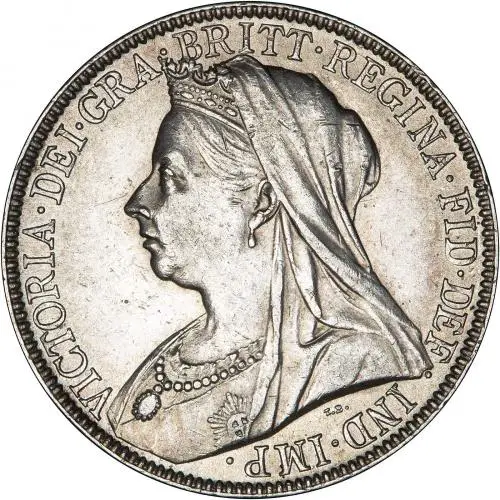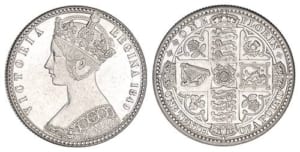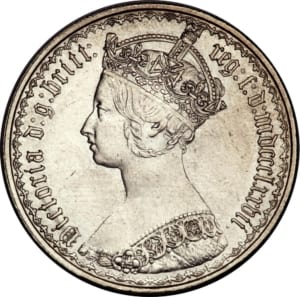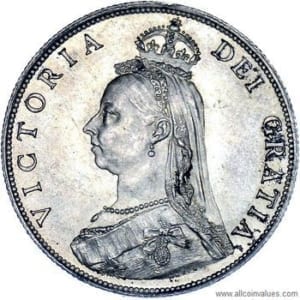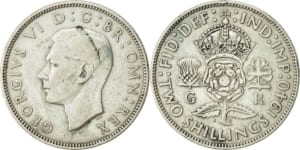The florin was introduced into the UK’s currency system under the reign of Victoria in 1849 as part of an early attempt at decimalisation.
It had a value equal to two shillings or one-tenth of a pound (10 pence). Over 100 years of the florin has led to many different designs and changes, but how much is a florin worth now?
Florins regularly sell anywhere from a few pounds to well into the hundreds of pounds, but this varies greatly depending on the year it was minted. Let’s take a look at some examples to get an idea of the varying values of florins today.
Godless Victoria Florin 1849-1851
Estimated Value = £50-£300
The first florin to be introduced into the UK currency system was during the reign of Victoria in 1849 and was minted in silver. The intricate reverse design showed the crowned cruciform shields of the UK with each nations’ emblem in the angles.
The obverse design was of Victoria as a very young woman and marked the first time in nearly 200 years that a British coin featured a portrait of the monarch wearing a crown.
What makes this particular florin so interesting is the inscription on the obverse side of the coin. Both sides of the coin were kept very simple with the reverse stating only the value of the coin, ‘ONE FLORIN ONE TENTH OF A POUND’, and the obverse reading ‘VICTORIA REGINA 1849’.
Problems arose when people noticed the obverse inscription was missing the usual D G for Dei Gratia, meaning By the Grace of God. This drew controversy from religious groups across the United Kingdom and the coin hence went on to be known as the ‘Godless Florin’.
The value of this coin greatly depends on the quality but is generally the highest of all the florins thanks to the low mintage and high precious metal content. Godless florins that are in good condition can sell for over £50 with excellent quality examples selling for as much as £300.
Gothic Victoria Florin 1851-1887
Estimated Value = £20
The Gothic style florin was introduced in 1951 to remedy the mistake of not including ‘D G’ on the previous version. The coin’s obverse and reverse designs were almost identical to that of the previous coin but now the obverse finally featured the inscription ‘Dei Gratia’.
The coin gets its ‘Gothic’ title thanks to the change in the font from the previously circulated florin and is in part due to the gothic style crown that Victoria is shown to be wearing in her portrait. The only other difference between the two florins is that in this new version, the inscription of the date is in Roman numerals.
As with the Godless florin, the value of a Gothic florin is highly dependent on its quality. Examples of the coin in fine quality are currently selling for anywhere between £15-£30 but there are many examples of the coin selling for up to £50.
Jubilee Victoria Florin 1887-1892
Estimated Value = £30
The Gothic florin remained unchanged and in circulation until 1887, in which a new florin was struck coinciding with the celebration of Victoria’s jubilee. The coin’s obverse showed Victoria as an older woman adorned in various jewels and wearing a smaller crown than previously.
The reverse design of the coin was also changed with the floral emblems of each nation being removed in favour of sceptres that laid diagonally between the shields. The Garter Star was added to the centre of the coin’s design.
The low relative mintage of the Jubilee florin means collectors are willing to pay to get their hands on one. We’ve seen many examples of the coin selling for around £30, but be careful you don’t get it confused with the double florin which was minted in the same period and typically sells for more.
Old Head Victoria Florin 1893-1901
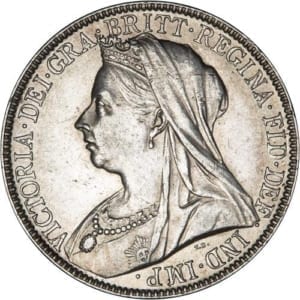
Estimated Value = £10
The final florin to have been minted during Victoria’s reign was the Old Head florin and was first released into circulation in 1893. The design change came after the Jubilee florin proved to be unpopular with the public. The new coin featured the same ‘Old Head’ Victoria bust on its obverse that was to be used on all silver and gold coinage in 1893.
The reverse design was also changed once again, this time featuring three shields separated by a rose, a shamrock, and a thistle symbolising the countries of England, Ireland, and Scotland respectively. The shields formed an inverted triangle with a single crown placed at the top of the coin’s design.
The Old Head florin sells for around £10 on eBay when in good condition, but very fine quality versions of the coin have sold for as much as £60.
Edward VII Florin 1902-1910
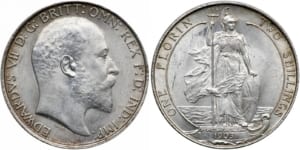
Estimated Value = £10
The death of Victoria led to a complete change in the design of the florin, with the obverse now featuring a crownless portrait of Edward VII. Not only this, but the reverse of the coin saw a total change in the style with the design now showing the figure of Britannia holding a shield in her left hand and a trident in her right. The design was reported to have been created to better distinguish the florin from the half-crown.
There is quite a lot of variation in the selling price of the Edward VII florin, with coins of the same quality selling for between £3 and £20. If you’re looking to sell one, we suggest waiting for a dip in the number of listings on eBay to get the best deal.
George V Florin 1911-1936
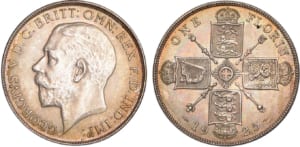
Estimated Value = £8
The year 1911 saw the original cruciform shields return to the reverse design of the florin during the reign of George V. The design featured four shields with crowns upon them, separated by sceptres. In 1927 this design was slightly modified, and the crowns were moved to sit upon the sceptres instead. The obverse portrait was of George V, crownless and facing to the left.
During the reign of George V, the metallic composition of the florin was changed several times to decrease the silver content due to rising prices.
As with the Edward VII florin, there is a lot of variation in the selling price for the George V florin. This could be due to the changes in metallic composition which have led to the coins not looking as good with age. In general, a good quality example of the coin sells for between £2 and £12.
Edward VIII Florin 1936
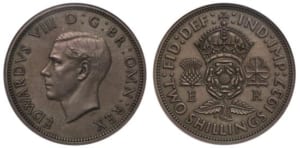
Estimated Value = n/a
The only florin on this list to never reach circulation was the Edward VIII florin. During his short reign, coins continued to be minted using the designs of George V whilst preparations went ahead for the new coinage to go into circulation.
A pattern florin was created with a new reverse design of a crowned Tudor rose over a leek with a Shamrock to the right and thistle to the left, representing all four nations of the UK. The coin was sadly never issued though as Edward VIII abdicated in December of 1936.
This particular florin was never minted and so they are not available to buy. This hasn’t stopped people from selling fake versions of the florin that have been struck using the originally intended pattern. These can typically be bought for around £3 if you’re looking to add one to your collection.
George VI Florin 1937-1952
Estimated Value = £2.50
The florin made for George VI closely resembles the one intended for this brother. The reverse design was of the same crowned Tudor Rose but this time with a G engraved below the thistle and an R below the shamrock.
In 1947, the coin’s metallic composition was finally changed to be struck entirely in cupro-nickel with no precious metal content included. Two years later in 1949, the inscription of ‘IND IMP’ was to be no longer struck on the florin in acknowledgement of India’s independence.
The change in the metallic composition has led to a decrease in the resell value of the florin, with the George VI florin only selling for around £2.50 on eBay.
Elizabeth II Florin 1953-1967
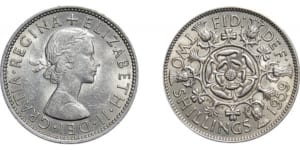
Estimated Value = £1.50
The final versions of the florin came during the reign of Elizabeth II. The reverse design still featured the Tudor rose but this time without a crown, and the thistles, shamrocks, and leeks were arranged in a circle surrounding the rose.
The florin continued to be struck until 1967, four years prior to Decimalisation Day in the UK. It remained as legal tender, equivalent to the new 10 pence piece, for several years until being officially demonetised on June 30 1993.
As with the George VI florin, the Elizabeth II florin has a relatively low resell. Good quality examples of the coin sell for around £1.50 although some very fine examples are fetching as much as £6. Due to the relatively recent removal from the UK’s currency system, a larger number of the coins are still in excellent condition so you could still be in with a good profit.
Where Were The First Florins Struck?
The first Florins were struck in the Republic of Florence in 1252, which is where the name florin actually comes from.
The original Florin coin was struck in gold and used in the Republic of Florence between 1252 and 1533, although it was not until 1849 that the British Florin was to be introduced.
Final Thoughts
The florin underwent many changes during its time in the UK’s currency system resulting in several different versions being minted. If you’ve held on to a few from before their withdrawal, or you’ve inherited some from older relatives, you’re bound to make a profit if you can find the right buyer.
Don’t forget to check out our articles about other coins from before the decimalisation of the UK’s currency system, such as the farthing and the shilling.
If you have any questions for us here at The Coin Expert, please contact us here.
